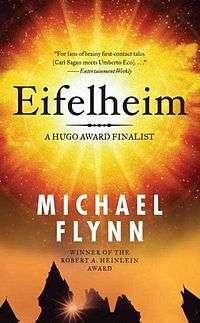Eifelheim
 | |
| Author | Michael Flynn |
|---|---|
| Country | United States |
| Language | English |
| Genre | Science fiction |
| Publisher | Tor Books |
Publication date | October 17, 2006 |
| Media type | Print (Hardcover & paperback) |
| Pages | 320 (hc) |
| ISBN | 978-0-7653-0096-6 |
| OCLC | 64289026 |
| 813/.54 22 | |
| LC Class | PS3556.L89 E35 2006 |
Eifelheim is a science fiction novel by American author Michael Flynn, published in 2006. It was nominated for a Hugo Award for Best Novel in 2007. It first appeared as a novella in 1986, which was a nominee for Best Novella Hugo Award in 1987.
Plot summary
In 1349, Eifelheim, a small town in the Black Forest of Germany, vanished: it ceased to appear on any maps or in any documents, having apparently been abandoned and never resettled by its community. The disappearance is no mystery — the Black Death devastated Europe. But why was the area never resettled, unlike most other depopulated areas? The mystery intrigues cliometric historian Tom Schwoerin, who sets out to solve the puzzle with the help of his partner, theoretical physicist Sharon Nagy. They gradually uncover evidence of an alien crash-landing in the area.
The village was originally called Oberhochwald, and then afterwards renamed Teufelheim (Devil home in German), which was eventually distorted to Eifelheim. They also learn of the town's priest, Father Dietrich, an educated man who served the town in 1348, as the Black Death was beginning to strengthen its grip on medieval Europe. Dietrich, it appears, acted as humanity's first ambassador, and was the primary liaison between Eifelheim and the aliens who happened to wreck their starship in the woods outside the village.
The novel concentrates primarily on the alien encounter in the 14th century, paying special attention to the interplay between Dietrich, a Christian scholar who is fond of Aristotle and metaphor, and the technologically advanced, post-Einsteinian band of otherworldly travelers. The interplay includes two theological questions. The first, "can aliens become Christians?" is answered in the affirmative, as some of them become converts. The second, "where is God when things go wrong?" is more difficult to answer, for both the Germans and the alien Krenken. The Germans are stricken by the Black Death, and the Krenken, who are immune to the disease, but cannot return to their home, require an amino acid not found in earthly organisms. The answer is two-fold: there is always hope, and God's love is expressed to us in the unselfish love of fellow creatures. Dietrich's attempts to understand the science of the Krenken (their view of the solar system, and gravity, is quite different from his) and their attempts to explain it to him, are also an important theme.
William of Ockham appears as a minor character. Nagy's search for a new physics, which will lead to a new means of space travel, is helped by Schwoerin's research. He discovers a Krenken circuit diagram, drawn in a manuscript by monks.
Literary significance and reception
Regina Schroder in her review for Booklist wrote "Flynn credibly maintains the voice of a man whose worldview is based on concepts almost entirely foreign to the modern mind, and he makes a tense and thrilling story of historical research out of the contemporary portions of the tale."[1] Kirkus Reviews praised the novel calling it "Another meticulously researched, intense, mesmerizing novel (based in some part on a 1986 short story) for readers seeking thoughtful science fiction of the highest order."[2] Entertainment Weekly said that the novel was for fans of "Brainy first-contact tales (Carl Sagan meets Umberto Eco)". According to their review , the novel was "bursting with pungent historical detail and Big Theme musings, this dense, provocative novel offers big rewards to patient readers."[3]
Notes
External links
- Eifelheim title listing at the Internet Speculative Fiction Database